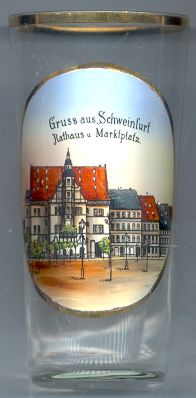

|
| DEUTSCHLAND | GERMANY |
| Bundesland: Freistaat Bayern | Bavaria |
| Regierungsbezirk: Unterfranken | |
| Stadt: Schweinfurt |
 Schweinfurt is situated at an elevation of 209 m on the river Main in Lower Franconia in northern Bavaria.
Schweinfurt is situated at an elevation of 209 m on the river Main in Lower Franconia in northern Bavaria.
Schweinfurt was first mentioned in a doscument of 791 AD. The early spellings include Suinuurde, Swinvordi and Sweinvort. In the 13th century Schweinfurt obtained the status of a town. In 1254 it became a Free Imperial Town and could retain this status for almost 550 years. In 1386 Schweinfurt joined the Swabian League of Cities (Schwäbischer Städtebund), a primarily military union of Imperial cities headed by Ulm, which intended to secure their rights and freedoms. In 1542 the Reformation was introduced in Schweinfurt. When in 1606 the Imperial city of Donauwörth was occupied and annexed by Bavaria, Protestant princes and cities in 1608 formed the Protestant Union, which was joined by Schweinfurt in 1609. The Reichsdeputationshauptschluss of 1802 ended the independence of Schweinfurt which thereafter was incorporated into Bavaria. During the 19th century Schweinfurt became a centre of industry. In 1852 it was connected to the railroad system. The town later became a centre of the production of roller bearings. During World War II Schweinfurt suffered severe damages as it was the target of several strategic bombing raids.
The pigment Schweinfurt Green (also known as Emerald Green, Paris Green, Vienna Green or C.I. Pigment Green 21), copper(II) aceto-arsenite, was invented around 1800. It obtained its popular name because it was first manufactured on an industrial scale here. The production was transfered to Schonungen in the district Schweinfurt in 1814. The dye became very popular because at the time it was unrivaled in its brilliance and lightfastness. However, due to its content of arsenic which can be liberated by environmental actions, the dye is also extremely toxic (hence the German expression 'giftgrün', 'toxic green', for a very bright and intense shade of green). Emerald Green was one of the favourite colours by many painters including Cézanne, Van Gogh and Monet. It has been speculated that Cézanne's diabetes, Monet's blindness and Van Gogh's neurological disorders might be linked to this arsenic-containing dye. The common name 'Paris Green' is derived from the fact that it was once used to kill rats in the Parisian sewers. The dye was banned in Germany in 1882.
The  town hall [left] was built in 1570–1572 in late Gothic and
early Renaissance style. The building was damaged in World War II but was restored after the war.
town hall [left] was built in 1570–1572 in late Gothic and
early Renaissance style. The building was damaged in World War II but was restored after the war.
![[scale]](lineal.jpg)